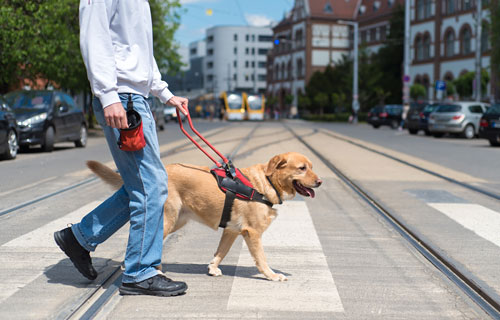Labor Day has passed, but we’re not through celebrating. That’s because National Guide Dog Month is now upon us. Yup! From Sept. 1-30 we’ll be commemorating the remarkable bond between humans and dogs – especially blind and visually impaired humans and their guide dogs. Not only do guide dogs, aka seeing eye dogs, help their people find their way, they also enhance their independence, increase their safety, and may even help them form social connections.
We’ve done some digging (pun intended!) and discovered these fun facts.
How did guide dogs come to be?
According to National.com, dogs were domesticated approximately 150,000 years ago and have coexisted with humans ever since. In fact, “ancient artifacts and scrolls show instances where dogs were guiding their human companions.” The earliest known attempt to train dogs to lead the blind was at Les Quinze-Vingts Hospital For the Blind in Paris, France.
When and why did they first come to the U.S?
After WWI, when many soldiers returned home having lost their eyesight in combat, demand for guide dogs soared. This led to the creation of the very first school for guide dogs in Oldenburg, Germany. Dorothy Harrison Eustis, an American breeder and philanthropist is credited with bringing the first guide dog to the U.S. Later, she founded a training facility for guide dogs in New Jersey.
What does it take to become a guide dog?
Only dogs with an exceptional temperament, high intelligence and excellent health make the cut. The journey to become a guide dog begins at eight weeks, when carefully bred puppies are placed with volunteer trainers who teach them basic commands and socialization skills. Dogs that do well start formal training at 14-18 months old. At that time, they begin work with professional instructors. Typically, training lasts for at least five months.
How do guide dogs help their handlers?
According to Guidedogs.org, guide dogs are trained to “lead their handlers around obstacles, indicate stairs and street curbs, target doorways and other useful landmarks, among countless their other tasks.” Once their training is complete, guide dogs are matched to a compatible handler and the relationship between dog and human develops.
How do guide dogs make a difference?
Guide dogs can be life-changing for blind people and people with low vision. Instead of relying solely on others for assistance, handlers take charge of their own comings and goings. This creates a meaningful sense of autonomy and confidence that may translate into opportunities in areas such as education, employment, socialization and community participation. The partnership between handlers and their guide dogs cannot be underestimated.
How can you get one?
The first step to getting a guide dog is finding a guide school. Guide schools are responsible for training dogs and prospective handlers. Look for schools in your area, as schools may have different catchment areas and programs. Once you find a school that seems right for you, review the eligibility requirements. For example, Guide Dogs Foundation in Smithtown, New York. mandates that prospective applicants “must be legally blind and can demonstrate the need for a guide dog to help them remain safe and effective in their everyday travel.” In addition, Guide Dogs Foundation prefers applicants that are able to “independently travel practical and purposeful routes with their current mobility device.”
Once you establish that you meet the organization’s criteria, it’s time to complete an application and provide documents such as medical reports, references, and sometimes an application video that shows evaluators what your lifestyle is like and demonstrates your health, and independent travel skills. The next steps to qualify are typically an in-home interview and an evaluation that assesses what sort of guide dog will best meet your needs. Once accepted to the organization’s guide dog program, you’ll be matched with a dog and receive rigorous training for community and residential settings. The best part? Guide dogs are free to people who qualify!
Happy Guide Dogs Month!


